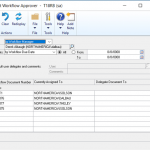(Or: How I Learned to Stop Worrying and Love My Workflow)

Dealing with inefficiencies in your business is probably one of the most stressful and tedious side effects of any operation. Of course, we all want to minimize waste where we can, but it often feels like an intangible, abstract mountain to climb.
Even that very first step towards improvement — identifying areas in your process that are hot spots for waste — can be challenging. If you’ve been utilizing the same processes for a while, it can be hard to imagine doing it any other way. To combat this, we’ve compiled some common areas of wasted time and effort that your company can improve or avoid altogether.
When you’re working in a world of manufacturing and distribution, your products move through many hands over the course of several days, and there’s plenty of opportunities for things to be derailed along the way. There are several major categories of waste that can plague your operations, spanning from actual dysfunction to a less-than-optimal order fulfillment time.
Defect Waste
This form of waste is pretty much exactly what it sounds like. If you end up shipping the wrong product, or the product becomes defective or broken during the shipping process, that counts as a big area of wasted potential. This one can be a little harder to manage since it depends in some part, on fate, but with a little preventative care, it can still be minimized.
Solution
Combating this type of waste doesn’t necessarily mean that you’ll never have a defective product again, but it does mean you can catch it as soon as possible, before costs you time and money that won’t be earned back. To achieve this, you’ll need direct visibility into your pipeline so you can track every touchpoint your inventory reaches and identify dysfunction right at the source. Establishing a workflow to track each order, from entry to fulfillment, will ensure that you can check in on your products whenever necessary.
Waiting Waste
Any materials that have yet to be assembled and inventory that hasn’t yet sold has no value to the customer. The more time these items stay in these phases of your operation, the more time you’re wasting. You want your products to move from manufacturer to warehouse to distributor as seamlessly as possible to avoid this waste, but oftentimes, you’ll run into a few hiccups when trying to move them from one stage to another.
Solution
Finding ways to automate your processes wherever possible is going to be your biggest lifesaver here. There’s no reason to process things manually when there are a million other things on your to-do list that are begging for your attention. You can customize your automated actions to run scripts, forward documentation, and update batches so that you won’t have to perform these menial tasks manually.
Personnel Waste
Sometimes, it’s not the product that’s being wasted, but the manpower that’s being poured into its journey to the customer. This often looks like a backup in your workflow where the process is being held up by next action someone else needs to take, or maybe by an ill-informed dispersal of efforts throughout your operations, where the knowledge and skills of your workforce aren’t being used to their greatest potential.
Solution
This may be something that falls to the upper-level management of your company. It’s important to regularly take stock of how your staff is functioning within their roles and their departments, and determine if a reorganization of talents might give your operations an extra boost. This might also look like a comprehensive training program for your employees where they can learn important best practices that help cut any areas where non-value added effort is being expended. You also might want to implement an improved system of communication between people across departments so there’s no lag when moving your product along.
Motion Waste
In the world of product-centric business, movement doesn’t always equate to progress. Motion waste refers to the idea that your product may be moving through several steps of processing, but it’s not getting any closer to its end goal. Inefficient driving routes or a poorly organized warehouse can be big contributors to this dance of one step forward, two steps back. Solution
When looking to optimize your warehouse to avoid superfluous movement, it’s important to ask yourself one key question: are you tracking or managing your inventory? If it’s the former, then you’re only privy to information regarding the cost of your inventory. By managing your inventory, you get a more complete view of pricing and purchasing, as well as an idea of how to organize your warehouse more efficiently, whether that’s through storing your inventory differently, finding space that’s poorly organized, or managing any other factors that could be slowing down your inventory’s movement or sending it in circles.
Excess Processing Waste
This term may seem like a catch-all description, but it actually refers to something a little more specific. Excess processing often takes the form of those frustrating moments where you’re forced to duplicate your efforts or are stretching your operations process beyond what you need to be successful. Now, we’re not going to tell you to only do the bare minimum you need to operate, but there are plenty of ways you can reassess your process to eliminate unnecessary and self-inflicted roadblocks.
Solution
Sometimes the best way to locate time sinks is to get an outside perspective. By undergoing a Business Process Review, you can have a pair of fresh eyes look over your operating procedures. This helps to determine where your workforce’s energy can be better applied so you can eliminate unnecessary steps in your workflow, combine several processes into one step, and move your product through the pipeline with as few touch-points as possible.
Ultimately, some waste is inevitable. And while it might seem like a constant uphill battle to be working against your own inefficiencies, if you can eliminate or update a few major areas where time and effort are being sent down the drain, you’ll see a huge difference in your day-to-day operations.
If you’re interested in learning more about finding ways to cut out waste in your business, check out our recent webinar on utilizing Six Sigma principles.





